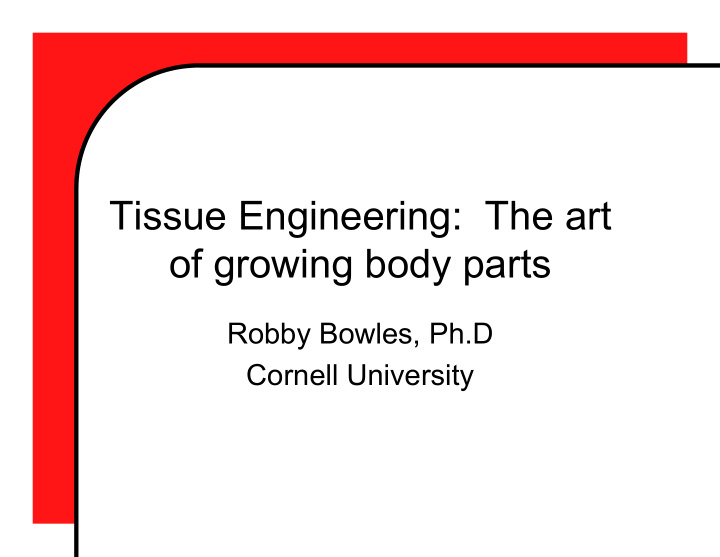



Tissue Engineering: The art of growing body parts Robby Bowles, Ph.D Cornell University
What is Tissue Engineering?
What is Tissue Engineering? • TE is an interdisciplinary field that applies the principles of engineering and the life sciences towards the development of biological substitutes that restore, maintain, or improve tissue function
What is Tissue Engineering? • TE is an interdisciplinary field that applies the principles of engineering and the life sciences towards the development of biological substitutes that restore, maintain, or improve tissue function • Developing living tissue using cells, biomaterials, and signaling molecules
What is Tissue Engineering? • TE is an interdisciplinary field that applies the principles of engineering and the life sciences towards the development of biological substitutes that restore, maintain, or improve tissue function • Developing living tissue using cells, biomaterials, and signaling molecules
Some Fabricated Tissue Engineering Constructs • Cartilage • Lung • Trachea • Heart • Skin • Bone • Kidney • Blood Vessel And Many More!
Need for Replacement • Skin - 3 million procedures per year • Bone - 1 million procedures per year • Cartilage - 1 million procedures per year • Blood Vessel - 1 million procedures per year • Kidney - 600 thousand procedures per year • Liver - 200 thousand procedures per year • Nerve - 200 thousand procedures per year
Why Tissue Engineering?
Why Tissue Engineering? • Traditional Implants (hip replacement…) – Poor biocompatibility – Mechanical Failure (undergo fatigue, wear, corrosion)
Why Tissue Engineering? • Traditional Implants (hip replacement…) – Poor biocompatibility – Mechanical Failure (undergo fatigue, wear, corrosion)
Why Tissue Engineering? • Traditional Implants (hip replacement…) – Poor biocompatibility – Mechanical Failure (undergo fatigue, wear, corrosion)
Why Tissue Engineering? • Traditional Implants (hip replacement…) – Poor biocompatibility – Mechanical Failure (undergo fatigue, wear, corrosion) • Transplants – Rejection – Disease transmission – Supply << Demand
3 Tools of Tissue Engineering
3 Tools of Tissue Engineering • Cells – Living part of tissue – Produces protein and provides function of cells – Gives tissue reparative properties
3 Tools of Tissue Engineering • Cells – Living part of tissue – Produces protein and provides function of cells – Gives tissue reparative properties • Scaffold – Provides structural support and shape to construct – Provides place for cell attachment and growth – Usually biodegradable and biocompatible
3 Tools of Tissue Engineering • Cells – Living part of tissue – Produces protein and provides function of cells – Gives tissue reparative properties • Scaffold – Provides structural support and shape to construct – Provides place for cell attachment and growth – Usually biodegradable and biocompatible • Cell Signaling – Signals that tell the cell what to do – Proteins or Mechanical Stimulation
Combinations of Tools
Combinations of Tools • Cells alone – Carticel - commercially available product
Combinations of Tools • Cells alone – Carticel - commercially available product • Purified Signaling molecules – Bone Morphogenic Protein for osteoblasts – Inject into tissue to encourage new tissue growth
Combinations of Tools • Cells alone – Carticel - commercially available product • Purified Signaling molecules – Bone Morphogenic Protein for osteoblasts – Inject into tissue to encourage new tissue growth • Cells in Scaffold – Chondrocytes (cartilage cells) in alginate hydrogel
Combinations of Tools • Cells alone – Carticel - commercially available product • Purified Signaling molecules – Bone Morphogenic Protein for osteoblasts – Inject into tissue to encourage new tissue growth • Cells in Scaffold – Chondrocytes (cartilage cells) in alginate hydrogel
Toothpicks and Tissue Engineering
Scaffold
What do we want in a scaffold?
What do we want in a scaffold? • 1. Biocompatible
What do we want in a scaffold? • 1. Biocompatible • 2. Biodegradable
What do we want in a scaffold? • 1. Biocompatible • 2. Biodegradable • 3. Chemical and Mechanical Properties
What do we want in a scaffold? • 1. Biocompatible • 2. Biodegradable • 3. Chemical and Mechanical Properties • 4. Proper architecture
What do we want in a scaffold? • 1. Biocompatible • 2. Biodegradable • 3. Chemical and Mechanical Properties • 4. Proper architecture
What do we want in a scaffold? • 1. Biocompatible • 2. Biodegradable • 3. Chemical and Mechanical Properties • 4. Proper architecture
What do we want in a scaffold? • 1. Biocompatible • 2. Biodegradable • 3. Chemical and Mechanical Properties • 4. Proper architecture
Types of Materials
Types of Materials • Metals – Not Degradable
Types of Materials • Metals – Not Degradable • Ceramics – Stiff – Brittle – Long Degradation
Types of Materials • Metals – Not Degradable • Ceramics – Stiff – Brittle – Long Degredation • Polymers – Wide range of properties
What is a polymer? • Molecule made from a large number of H H repeatable units • Advantages C C – Control of n H H architecture, reactivity, and degradation
Polymers in TE • Natural • Synthetic – Derived from ECM – Made by controlled process • + preprogrammed • + Generally • +/- Range of biocompatible biological responses • +Biological • +/- Range of degradation degradation mechanism • Established production protocol • - not made, purified
Architecture • Pore size – Average diameter of pores • Porosity – Porosity volume/total volume • Interconnectivity • Porogeneration (melt molding)
Methods of Cell Delivery • Cell Adhesion (solid/dry scaffolds) • Cell Encapsulation – Polymer solution to solid
What Properties Do We Want In A Scaffold?
Recommend
More recommend